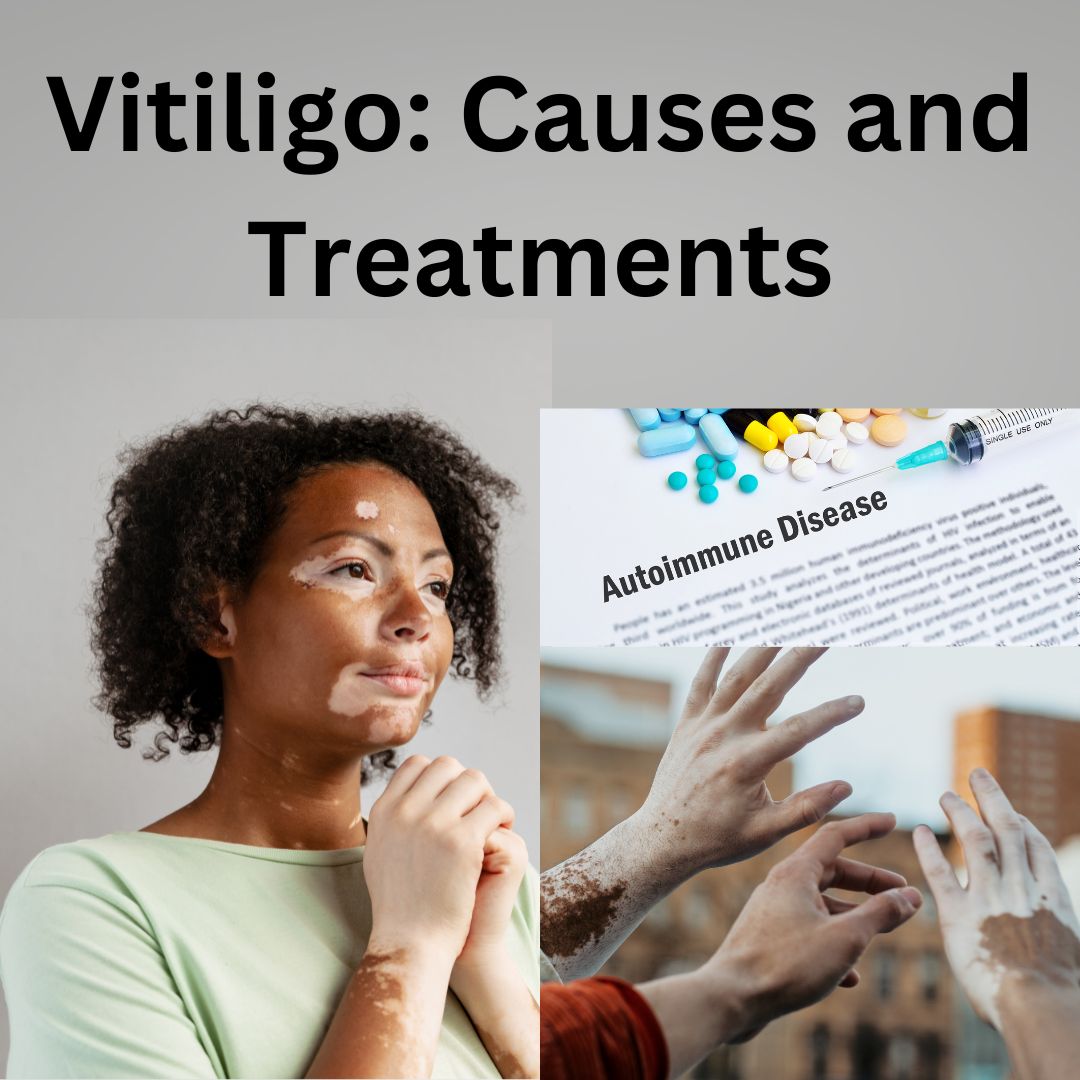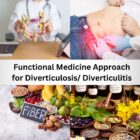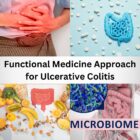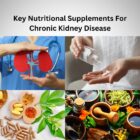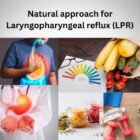Vitiligo: Functional Medicine Approach
Vitiligo is characterised by depigmentation of patches of skin, resulting from the destruction of melanocytes (which produce the pigment, melanin) in the epidermis. The cause of vitiligo primarily due to autoimmune disease and specially due to leaky GUT. Imagine waking up one morning to find patches of your skin losing their natural pigmentation, leaving behind a stark contrast against your unaffected areas. This perplexing condition, known as vitiligo, affects millions of people worldwide, irrespective of age or ethnicity. But what causes this mysterious condition, and is there any hope for treatment? In this blog, we delve into the details of vitiligo, exploring its causes, potential triggers, and available natural treatment options.
What happens in Vitiligo
Vitiligo is a chronic skin disorder due to the loss of melanocytes, the cells responsible for producing the pigment melanin. In individuals with vitiligo, these melanocytes gradually destroy, leading to depigmented patches on various parts of the body.
Causes of Vitiligo
The causes of vitiligo are multifactorial, involving a combination of autoimmune disorders, oxidative stress, genetic factors, and other potential triggers. Vitiligo can negatively impact a person’s confidence and self-image, especially if it affects areas that can’t be hidden such as the face and hands. Conventional treatment for vitiligo involves ultraviolet light therapy, which can be very effective in improving the appearance. However, with conventional treatment only, the internal autoimmune process still remains because the underlying causative factors have not been. An integrative approach to vitiligo treatment is necessary to not only improve the appearance of the skin long term, but also address the root cause and prevent progression and development of other autoimmune conditions.
Common/General Causes:
Autoimmune Disorders: It is an autoimmune condition, where the immune system mistakenly attacks and destroys melanocytes, the pigment-producing cells in the skin. Researchers believe that the main cause of this condition involves a disruption in the immune system’s regulation, leading to the destruction of melanocytes.
Oxidative Stress: Oxidative stress refers to an imbalance between the production of harmful reactive oxygen species (ROS) and the body’s ability to neutralize them with antioxidants. Studies suggest that oxidative stress plays a role in the development and progression of vitiligo. Increased ROS levels damage melanocytes and impair their function, leading to depigmentation.
Genetic Factors: Genetic predisposition is another significant factor in the development of vitiligo. Family history studies show that certain genes are associated with an increased susceptibility to vitiligo. However, the exact genes involved and their specific mechanisms are still under investigation
Poor detoxification system: A weakened detoxification system contributes to the development of vitiligo. The body’s detoxification processes, such as the liver’s ability to metabolize and eliminate toxins, play a role in maintaining overall health. When the detoxification system is compromised, it leads to an accumulation of toxins that trigger an autoimmune response, potentially contributing to the onset or progression of vitiligo.
Other Significant/Specific Causes
Constipation: Chronic constipation negatively impacts overall health, including the skin. When waste products and toxins build up in the colon due to infrequent bowel movements, it puts a burden on the body’s detoxification mechanisms. The accumulation of waste products and toxins contributes to oxidative stress and inflammation, which affects melanocytes (the pigment-producing cells) in the skin, potentially leading to the development of vitiligo.
Low stomach acid: Adequate stomach acid is essential for proper digestion and absorption of nutrients. When stomach acid levels are low, the body may struggle to break down and absorb vital nutrients, such as vitamin B12, zinc, and copper. These nutrients are important for maintaining healthy skin and melanin production. Deficiencies in these nutrients lead to the development of vitiligo.
Gut dysbiosis: The gut microbiota plays a crucial role in maintaining immune function and overall health. Imbalances in the gut microbiota, known as gut dysbiosis, disrupt immune regulation and contribute to autoimmune conditions like vitiligo. Dysbiosis leads to increased intestinal permeability (leaky gut), allowing harmful substances to enter the bloodstream and trigger an immune response against melanocytes.
Low nutrients: Nutritional deficiencies impact various bodily functions, including skin health. In the context of vitiligo, deficiencies in specific nutrients like vitamin B12, vitamin D, zinc, and copper have been linked to its development or progression. These nutrients are involved in melanin synthesis, antioxidant defence, and immune regulation. Insufficient intake or poor absorption of these nutrients comprise the body’s ability to maintain healthy melanocytes and regulate the immune response in the skin.
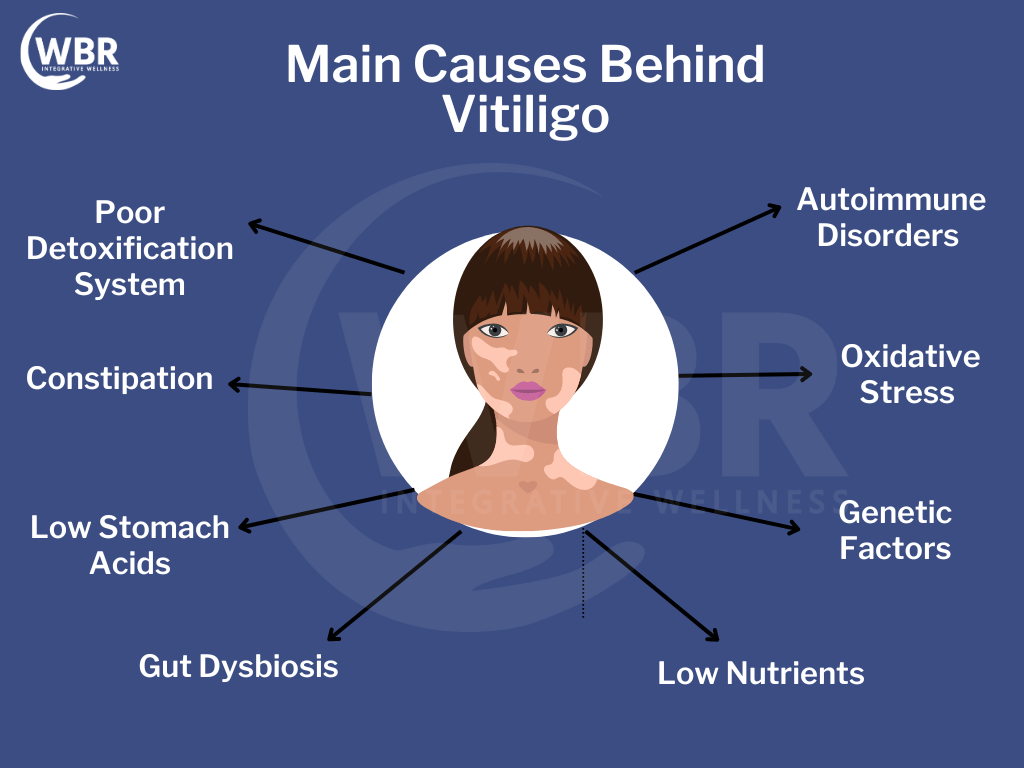
Different Types of Vitiligo
Vitiligo is classified into different types based on the distribution and pattern of depigmentation on the skin. The two main types of vitiligo are segmental and non-segmental vitiligo.
Segmental Vitiligo: Segmental vitiligo, also known as unilateral vitiligo, typically affects only one side or a specific segment of the body. It often starts at an early age and progresses rapidly for a period of time before stabilizing. This type of the condition stems from a localized neural or genetic defect and is less common than non-segmental vitiligo. Segmental vitiligo tends to be more stable and less responsive to treatment compared to non-segmental one.
Non-Segmental Vitiligo: Non-segmental vitiligo is the most common form of vitiligo, accounting for about 90% of cases. It is characterized by depigmented patches that appear symmetrically on both sides of the body. Non-segmental vitiligo affects any part of the body, including the face, hands, feet, and trunk. This type stems from an autoimmune basis, where the body’s immune system mistakenly attacks and destroys melanocytes. Non-segmental vitiligo often progresses slowly and is more responsive to treatment compared.
Different stages of Vitiligo
Vitiligo progresses through different stages with specific features and changes in the depigmented patches. The three main stages of vitiligo are active, stable, and recovering.
Active Stage: During the active stage, new depigmented patches continue to appear and existing patches expand in size. The depigmentation process is actively ongoing, and there are noticeable changes in the affected areas. This stage often leads to inflammation and itching or redness. The active stage is crucial for early intervention and treatment to prevent the further spread of depigmentation.
Stable Stage: In the stable stage, the depigmented patches stop spreading, with no active progression of the condition. The patches remain consistent in size and distribution for a long period, typically several months or more. The stable stage indicates a relatively inactive phase of vitiligo, where depigmentation stabilizes. However, the patches are still present and require management and treatment to improve pigmentation or prevent further depigmentation.
Recovering Stage: The recovering stage involves the return of pigmentation to previously depigmented areas. In some cases, spontaneous repigmentation may occur, resulting in the gradual reestablishment of melanin production and colour in the affected patches. This stage occurs spontaneously or with the help of treatment interventions. The recovering stage is a hopeful phase for individuals with vitiligo, as it indicates the potential for repigmentation and improvement in the appearance of the skin.

Dietary Support for Vitiligo
Dietary support plays a complementary role in managing vitiligo by providing essential nutrients and antioxidants that support skin health and possibly aid in repigmentation. Incorporating certain foods and nutrients into your diet is beneficial. Here are some dietary considerations for supporting vitiligo:
Antioxidant-rich Foods: Include foods high in antioxidants, such as fruits (berries, citrus fruits, grapes), vegetables (leafy greens, carrots, bell peppers), and legumes. Antioxidants help combat oxidative stress, which plays a big a role in vitiligo development.
Vitamin C: Foods rich in vitamin C, like citrus fruits, strawberries, kiwi, and bell peppers are helpful as vitamin C supports collagen production and aids in melanin synthesis.
Vitamin D: Adequate vitamin D levels are important for skin health. Include sources of vitamin D in your diet, such as fatty fish (salmon, mackerel), fortified dairy products, and egg yolks. Consult with a healthcare professional about appropriate vitamin D supplementation if necessary.
Omega-3 Fatty Acids: Foods rich in omega-3 fatty acids, such as fatty fish (salmon, sardines), flaxseeds, chia seeds, and walnuts, may have anti-inflammatory effects and promote overall skin health.
Zinc: Zinc is responsible for synthesis and immune function. Include zinc-rich foods like oysters, beef, poultry, nuts, and seeds in your diet. Zinc supplements may be considered under the guidance of a healthcare professional if there is a deficiency.
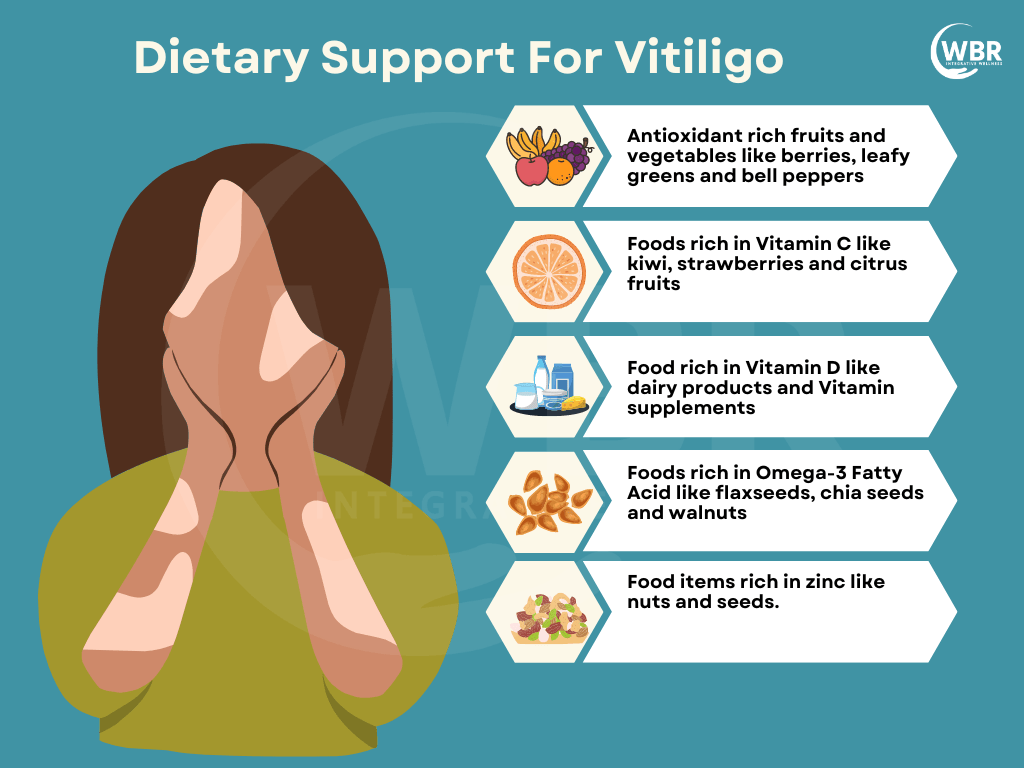
Lifestyle Support and Other Therapies
In addition to dietary support, certain lifestyle changes and therapies help manage vitiligo. Here are some lifestyle and treatment options to consider:
Sun Protection: Sun exposure exacerbates vitiligo, making it important to practice sun safety. Wear protective clothing and use a broad-spectrum sunscreen with an SPF of at least 30. Avoid tanning beds and be mindful of peak sun hours.
Topical Steroids: Topical steroids reduce inflammation and halt the progression of vitiligo. These are usually prescribed by a dermatologist and you should use them as per the directions given by the dermatologist to minimize side effects.
Topical Calcineurin Inhibitors: These medications are prescribed to reduce inflammation and halt the progression of vitiligo, but they have a lower risk of side effects compared to topical steroids.
Excimer Laser: Excimer laser therapy involves using a focused beam of UVB light to stimulate repigmentation in affected areas. This therapy requires multiple sessions, and results may vary from person to person.
Nutrition and Supplement Support
L-Phenylalanine and L-Tyrosine: It helps to re pigment the skin in vitiligo. It works by stimulating the production of melanin, the pigment responsible for skin colouration, and is taken orally or applied topically. Melanin is a protein that requires tyrosine (and iron as a cofactor) from our diet (phenylalanine is the essential amino acid from which we make tyrosine).
Topical Coenzyme Q10: Coenzyme Q10 is an antioxidant that helps protect cells from oxidative stress. The topical application of CoQ10 has potential benefits in vitiligo by reducing oxidative damage and promoting melanocyte activity.
Vitamin D: Vitamin D increases tyrosinase activity which may lead to re pigmentation in vitiligo skin lesions.
Glutathione (GSH): Glutathione is a well-known antioxidant able to protect cellular components by oxidative stress damage. Recently, some studies underline how its oral use as supplement may be useful in preventing cells photo- damage.
Alpha Lipoic Acid: This is another potent antioxidant that helps neutralize free radicals and reduce oxidative stress. Alpha lipoic acid builds a protective effect on melanocytes and assists in repigmentation of the skin in vitiligo when used topically or taken orally.
Para-Aminobenzoic Acid (PABA): PABA is a compound present in topical creams or is taken orally as a supplement for vitiligo. It protects against UV radiation and helps promote repigmentation of the skin by supporting melanocyte function.
Ginkgo Biloba Extract: Ginkgo biloba is a herbal extract known for its antioxidant and anti-inflammatory properties. You should consume it orally or use topically in vitiligo management to support melanocyte health and reduce oxidative stress in the skin.
Vitamin B Complex: B vitamins support overall skin health and play a role in melanin synthesis. Folate and B12 are most important one.
Essential Fatty Acids: Omega-3 fatty acids help reduce inflammation and support skin health. Specially choose a product having high amount of EPA vs DHA.
Calcium and Magnesium: These minerals are important for enzyme function and aid in reducing oxidative stress.
Methylsulfonyl-Methane (MSM): MSM supports collagen production and have anti-inflammatory effects.
Probiotics: Top one for autoimmune disease are L.Plantarum( 299v, PS128, HEAL9), L. Rhamnosus GG, L. Paracasei, Akkermansia Muciniphila, L. Acidophilus, B.Longum, B.Infantis, L. Gasseri and spore based such as B.Coagulans.
Prebiotics: Top one are apple pectin, FOS, GOS and acacia fiber which helps in restoring GUT health by supporting growth of healthy microbes.
Zinc Plus Copper: Zinc is involved in melanin production, while copper aids in its incorporation into skin cells.
Phytosome Curcumin and Quercetin: Phytosome has higher bioavailability and Curcumin proves to be natural anti-inflammatory option to reduce inflammation and oxidative damage. Quercetin can help in degrading the allergies and any skin issue due to autoimmune dynamics. Quercetin exhibited cytoprotective activities against the effects of hydrogen peroxidase which induced melanocyte apoptosis
Vitamin C with Bioflavonoids: Vitamin C is an antioxidant that supports collagen synthesis and enhances the immune system. Bioflavonoids enhance their effectiveness.
Note: Kindly consult your medical practitioner before taking any supplements on your own.
Functional Medicine Approach
Functional medicine can arrest the autoimmune process by re-balancing the immune system. In some vitiligo sufferers this can be enough to cause the skin to regain pigment. In others functional medicine approach stops spreading of vitiligo and conventional treatments are needed in order to stimulate the skin to produce pigment. It is important to restore GUT health with 5R (Remove, Replace, Reinoculate, Repair and Rebalance) approach.
Conclusion
Vitiligo is a complex skin disorder characterised by the loss of melanocytes and depigmented patches on the skin. While the exact cause of vitiligo remains elusive, factors such as autoimmune disorders, low stomach acid, leaky GUT, oxidative stress, genetic predisposition, and other triggers contribute to its development. Treatment approaches aim to manage the condition and improve the appearance of the skin. These include topical medications, phototherapy, functional approach to restore GUT health, calm down hyper active immune system, and lifestyle modifications. Additionally, dietary support, including antioxidant-rich foods and certain supplements, complements treatment efforts. However, it is crucial to consult with healthcare professionals to develop a personalised management plan based on individual needs.

